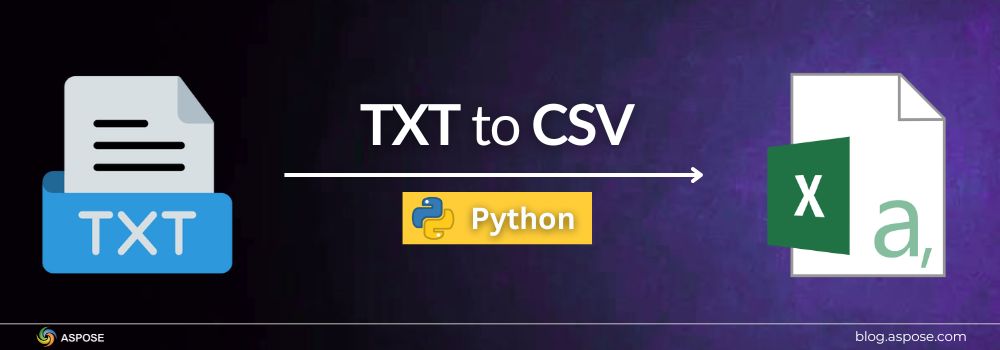Working with raw text files often requires exporting unstructured data into a cleaner and more organized format. Converting a TXT file to CSV makes it easier to analyze information, manage records, or import data into spreadsheet applications. In this article, you will learn how to convert TXT to CSV format using Python.
Why Convert a TXT File to CSV?
Text files (.txt) store data as plain text, usually separated by spaces, tabs, or other characters. While this format is simple, it can be difficult to manage or analyze. Converting it to a CSV file organizes the data into clear rows and columns, making it easier to work with in spreadsheets or data tools.
Common Use Cases
Converting TXT to CSV is helpful in many situations, such as
- Importing raw data from logs or system exports
- Cleaning and organizing data for reports or analysis
- Preparing datasets for use in Excel or other spreadsheet tools
The Python Text to CSV Converter Library
Aspose.Cells for Python via .NET is a powerful library that lets you create, edit, and convert Excel and CSV files, all without needing Microsoft Excel installed. It supports file conversion, formula calculation, chart generation, pivot tables, and much more. It simplifies the process of converting text files into structured CSV format.
You can download it from the releases or install it directly from PyPI using the following command:
pip install aspose-cells-python
Convert a TXT File to a CSV in Python
You can convert data from a text file into CSV format in Python. Just load the plain text file into memory and export the data to a CSV file.
Please follow the steps below to convert a text file to CSV format:
- Load the source TXT file using the
Workbookclass. - Save the content as a CSV file using the
save()method.
The following example demonstrates how to read a text file and export it as CSV.

Convert TXT File to CSV using Python.
Convert TXT to CSV with Delimiters
If your text file uses a delimiter other than a comma (such as a tab or semicolon), you can customize the load options before conversion.
Please follow the steps below:
- Create an instance of the
TxtLoadOptionsclass. - Specify load options, such as separator.
- Load the source TXT file using the
Workbookclass with load options. - Save the content as a CSV file using the
save()method.
The following example shows how to specify load options and convert TXT to CSV.

Convert TXT File to CSV with Delimiters.
Get a Free License
You can evaluate Aspose.Cells for Python via .NET without limits. Get a free temporary license and test all features, including conversions, formulas, charts, and large files.
Try the Online TXT to CSV Converter.
You can also try this free online TXT to CSV converter to quickly transform your text files into CSV format. It offers a fast and reliable way to export data without installing any software. Simply upload your TXT file, convert it, and download the resulting CSV within seconds.
Python TXT to CSV Conversion: Documentation and Tools
In addition to converting TXT files to CSV, Aspose.Cells for Python via .NET offers powerful features for managing data and spreadsheets. You can perform various tasks such as file conversions, applying formulas, formatting cells, creating charts, and generating pivot tables programmatically and without Microsoft Excel.
Check out the following resources to explore its full range of capabilities:
- Aspose.Cells for Python Documentation
- API Reference Guide
- Free Online Excel Conversion Tools
- Developer Tutorials and Examples
Conclusion
In this article, you learned how to convert a TXT file to CSV format using Python. This conversion is a key step in data cleaning and reporting. With Aspose.Cells for Python via .NET, you can automate the process, manage custom delimiters, and efficiently handle large datasets.
If you have any questions or need technical assistance, feel free to visit our Free Support Forum.
TXT to CSV Python: FAQs
Q1: Can I convert multiple TXT files to CSV at once?
Yes. You can loop through files in a directory and convert each one using the same logic.
Q2: Does Aspose.Cells require Microsoft Excel to be installed?
No. Aspose. Cells works completely independently and does not need Microsoft Excel or any other third-party applications to function.
Q3: Can I perform other conversions, like CSV to Excel or Excel to JSON?
Absolutely! Aspose. Cells supports a wide range of file conversions, including CSV to Excel, Excel to JSON, Excel to HTML, ODS, and many more.
